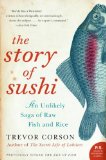The Story of Sushi: An Unlikely Saga of Raw Fish and Rice (P.S.)


I first learned of Trevor Corson and his books on the Haphazard Gourmet Girls website. Their irreverent interview series with this man who has gotten liquored up with Buddhist monks and is known as the Lobster Sex Guy (for his previous book, The Secret Life of Lobsters: How Fishermen and Scientists Are Unraveling the Mysteries of Our Favorite Crustacean (P.S.)
The motivation to keep turning the pages, however, was provided entirely by Corson. He’s spent significant time in China and Japan, learning about the language and the culture. And, of course, he learned about the Japanese sushi experience as well. He interacted with down-to-earth people who had regular lives. With his grounded approach, he invites us in to learn about sushi with intriguing and relevant background information and colorful characters, rather than pushing us away with dire warnings of an unapproachable ancient culture and our clumsy American habits.
He begins the story with Kate – a woman with no previous kitchen experience who decides to enroll in the academy after falling in love with the relationship that develops between a sushi chef and his or her regular customers. She spends a good portion of the first weeks outclassed by her peers and alternately yelled at and babied by her instructor. And the reader is invited into her angst – we come to understand and relate to Kate’s apprehensions and consequently overcome them with her and learn the art and science of sushi as she does.
We also learn about some of her fellow students. In particular, there’s Marcos, the blond-haired 17-year-old boy who’s there because he thinks working at a sushi bar will provide plenty of opportunity to meet women. And there’s also Takumi, the young Japanese man who, oddly enough, came to America specifically to learn to make sushi (we learn more about this as the story progresses).
The Yugoslav-Australian sushi instructor, Zoran and Toshi, the CEO of the academy are introduced early on. Through interactions between the students and their teachers, we learn about how the academy was formed and the coursework and craft presented there. Toshi, the main Japanese chef discussed in the book, is also not classically trained. He essentially learned about sushi on the job – in L.A. Sushi was on the upswing in California and was rapidly expanding into many parts of the U.S. Restaurants were opening at an alarming rate and often being staffed by folks with little or no sushi experience. The California Sushi Academy was a meet-me point between the traditional 5-year apprenticeship that chefs in Japan go through and the near-complete lack of knowledge many budding chefs currently possessed. It was an accessible way for students to receive sushi training and better serve their eventual employers and customers.
There is such an amazing wealth of information presented throughout the story that it’s difficult to narrow it down. Here are a few of the things I learned in reading this book:
- Fish shouldn’t be served freshly killed. It takes time for the necessary chemical reactions to take place so that the meat of the fish can develop flavor.
- Salmon are susceptible to parasites, and to be safely consumed raw, should be frozen in an industrial freezer to kill off the pests before being thawed and served. And, because salmon spend time in fresh water, it’s also possible for them to carry the larvae of tapeworms. Corson’s not pulling any punches here. He lets us know that tapeworms are, in fact, the main reason freshwater fish aren’t generally served raw.
- Geoducks (aka Giant clams) are, evidently, very phallic. The geoduck has a long, um, shaft protruding from its shell which it uses to siphon in food and water and spit out waste. He elaborates further, but I’ll leave it to you to delve into that one.
Beyond the main body of the story, there are a handful of extras. Thankfully, given the amount of information presented, there’s an index. Corson also includes a section on how to order and eat sushi. He includes extensive sections on his sources and a bibliography. There’s even a small dictionary. The book ends with segments describing the author’s life and the process he went through in making his way from spending time at the sushi academy to producing a completed manuscript.
The prevailing themes in the book seem to be that we, as customers, have to be open to the sushi experience. We must try to get beyond our comfort zones and let knowledgeable chefs provide us with a unique experience. On the other hand, sushi chefs and/or restaurants themselves may hold as much responsibility for our lack of knowledge as we do. Often they’ve either only had exposure to American-style sushi themselves or they fully understand traditional customs and preparations and assume folks in the States will not accept them. It’s even understandable – businesses survive by giving the customers what they want. However, the tide is changing. Many of us learn more about food and culture and crave authentic experiences. While it may still be difficult to get the full Japanese treatment, there are more sushi chefs who are interested in educating their clientele, presumably without too much intimidation and dogma.
With The Story of Sushi, Trevor Corson makes sushi accessible while unraveling its complexities. His information comes together and makes us yearn for that authentic experience. We find ourselves rooting for Kate and hoping that she succeeds. When she succeeds, we succeed. If she has the courage to drop everything and learn to prepare sushi, surely we can all come up with the courage to sidle up to the bar and ask the chef what’s fresh today.
Note: This book was previously titled “The Zen of Fish.”